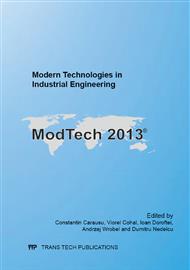p.363
p.369
p.375
p.381
p.387
p.393
p.399
p.405
p.411
A Survey on Capp Systems Development Methods
Abstract:
Process planning is one of the most important links in planning of the manufacturing system functioning, it coordinates and integrates processes planners, designers and economists intentions. The main goal to reach during the process planning phase is to determine the process plan structure it is manufacturing operations and cuts which have to be applied in order to transform given semifinished product into a product with the strict determined design and properties. Simultaneously process planers strive for working out such a process plan which satisfies criteria of the lowest manufacturing cost and labour consumption taking into account current accessibility of manufacturing resources. Process planning is still one of the most difficult, complex and time consuming process planner activities. Traditionally the process plan is designed with so-called manual method. During process planning with this method a process planner is forced to analyse the sequence of manufacturing cuts and operations in the process plan structure and also to analyse alternative processes taking into consideration achieving as low as possible unit manufacturing cost. In this case the process plan quality in principle depends exclusively on process planner knowledge and skills. Taking into account above the methods of process planning functions automation are searched. This goal can be reached by application of computer tools. Computer methods of process planning went through the long evolution process and their development is characterized by the following features: decreasing of process planner participation in the planning of the base structure of process plan, broad application of technological databases, broad application of technological knowledge bases, and possibilities of cooperation with commercial CAD/CAM/CAE systems [1,. In this paper the detailed information on methods of computer aided process planning are given. The variant, semi generative and generative methods are discussed. The main merits and drawbacks for each method are shown.
Info:
Periodical:
Pages:
387-392
Citation:
Online since:
November 2013
Price:
Сopyright:
© 2014 Trans Tech Publications Ltd. All Rights Reserved
Share:
Citation:


